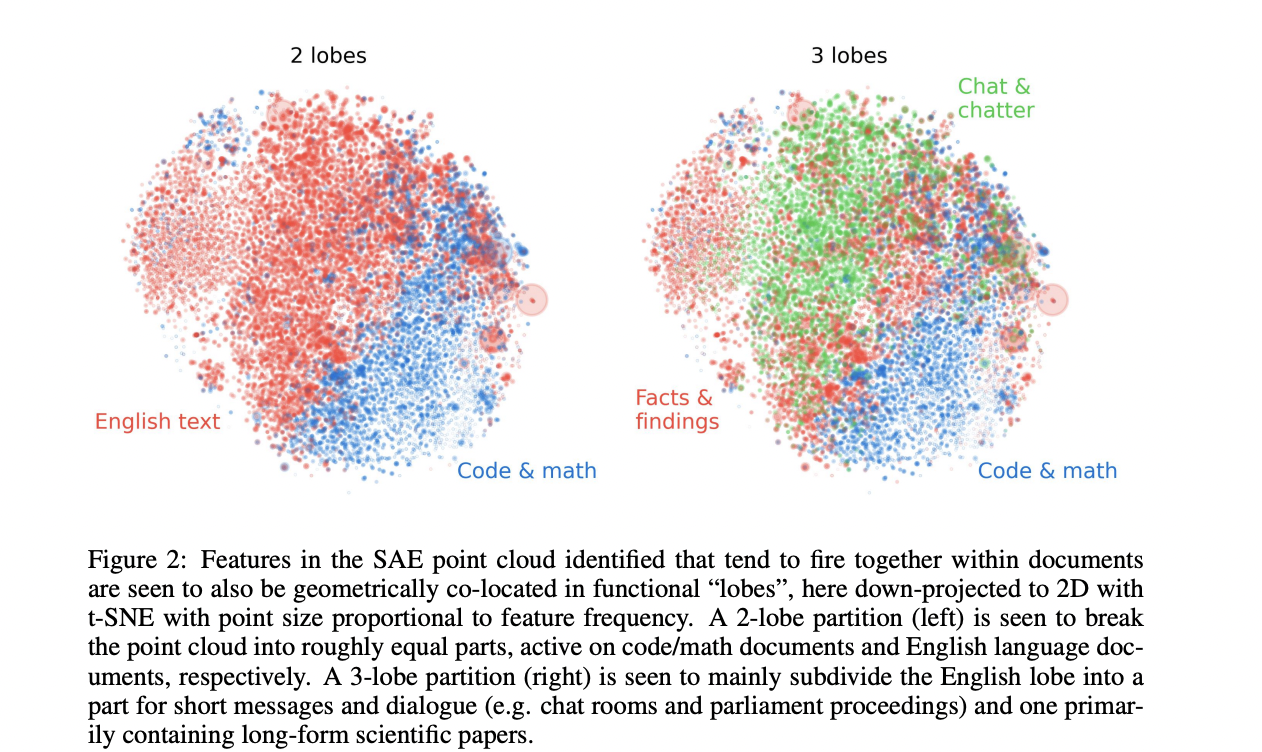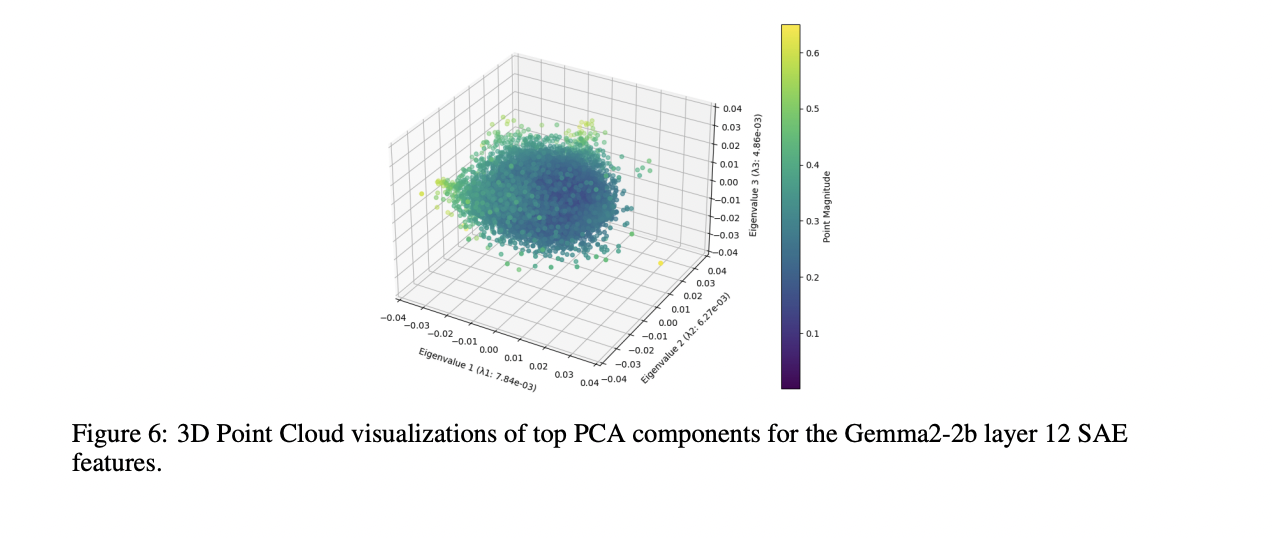Large language models (LLMs) have become powerful tools in natural language processing, but understanding their internal representations remains a major challenge. Recent advances using sparse autoencoders have revealed interpretable “features” or concepts within the activation space of models. While these discovered feature point clouds are now publicly accessible, understanding their complex structural organization at different scales presents a crucial research problem. The analysis of these structures involves multiple challenges: identifying geometric patterns at the atomic level, understanding functional modularity at the intermediate scale, and examining the overall distribution of features at the larger scale. Traditional approaches have struggled to provide a comprehensive understanding of how these different scales interact and contribute to model behavior, making it essential to develop new methodologies to analyze these multi-scale structures.
Previous methodological attempts to understand the feature structures of LLM have followed several different approaches, each with its limitations. Sparse autoencoders (SAEs) emerged as an unsupervised method for discovering interpretable features, initially revealing neighborhood-based clusters of related features through UMAP projections. Early word embedding methods, such as GloVe and Word2vec, discovered linear relationships between semantic concepts, demonstrating basic geometric patterns such as analogical relationships. While these approaches provided valuable insights, they were limited by their focus on single-scale analysis. Meta-SAE techniques attempted to decompose features into more atomic components, suggesting a hierarchical structure, but struggled to capture the full complexity of interactions at multiple scales. Analysis of feature vectors in sequence models revealed linear representations of various concepts, from playing positions to numerical quantities, but these methods generally focused on specific domains rather than providing a comprehensive understanding of the geometric structure of the feature space in different scales.
Researchers at the Massachusetts Institute of technology propose a robust methodology for analyzing geometric structures in SAE feature spaces through the concept of “crystalline structures”: patterns that reflect semantic relationships between concepts. This methodology extends beyond simple parallelogram relationships (such as man:woman::king:queen) to include trapezoidal formations, which represent single-function vector relationships, such as country-to-capital mappings. Initial investigations revealed that these geometric patterns are often obscured by “distractor features”: semantically irrelevant dimensions such as word length that distort expected geometric relationships. To address this challenge, the study introduces a refined methodology that uses Linear Discriminant Analysis (LDA) to project the data into a lower-dimensional subspace, effectively filtering out these distracting features. This approach allows for clearer identification of significant geometric patterns by focusing on signal-to-noise eigenmodes, where signal represents variation between groups and noise represents variation within groups.

The methodology expands to the analysis of larger scale structures by investigating functional modularity within the SAE feature space, similar to specialized regions in biological brains. The approach identifies functional “lobes” through a systematic process of analyzing the coexistence of features in document processing. Using a layer 12 residual flow SAE with 16,000 features, the study processes documents from The Pile dataset, considering features as “activated” when their hidden activation exceeds 1 and recording co-occurrences within blocks of 256 tokens. The analysis employs several affinity metrics (simple coincidence coefficient, Jaccard similarity, Dice coefficient, overlap coefficient, and Phi coefficient) to measure relationships between features, followed by spectral clustering. To validate the spatial modularity hypothesis, the research implements two quantitative approaches: comparing mutual information between geometry- and co-occurrence-based clustering results and training logistic regression models to predict functional lobes from geometric positions. This comprehensive methodology aims to establish whether functionally related features exhibit spatial clustering in activation space.
Analysis of the large-scale “galaxy” structure of the characteristic SAE point cloud reveals distinct patterns that deviate from a simple isotropic Gaussian distribution. Examination of the first three principal components demonstrates that the point cloud presents asymmetric shapes, with variable widths along different principal axes. This structure resembles biological neural organizations, in particular the asymmetric formation of the human brain. These findings suggest that the feature space maintains organized and non-random distributions even at the largest scale of analysis.

Multiscale analysis of SAE feature point clouds reveals three distinct levels of structural organization. At the atomic level, geometric patterns emerge in the form of parallelograms and trapezoids that represent semantic relationships, particularly when distracting features are removed. The intermediate level demonstrates functional modularity similar to that of biological neural systems, with regions specialized for specific tasks such as mathematics and coding. The galaxy-scale structure exhibits a non-isotropic distribution with a characteristic power law of eigenvalues, most pronounced in the middle layers. These findings significantly advance the understanding of how linguistic models organize and represent information at different scales.
look at the Paper. All credit for this research goes to the researchers of this project. Also, don't forget to follow us on twitter.com/Marktechpost”>twitter and join our Telegram channel and LinkedIn Grabove. If you like our work, you will love our information sheet.. Don't forget to join our SubReddit over 55,000ml.
(Trend) LLMWare Introduces Model Depot: An Extensive Collection of Small Language Models (SLM) for Intel PCs
Asjad is an internal consultant at Marktechpost. He is pursuing B.tech in Mechanical Engineering from Indian Institute of technology, Kharagpur. Asjad is a machine learning and deep learning enthusiast who is always researching applications of machine learning in healthcare.
<script async src="//platform.twitter.com/widgets.js” charset=”utf-8″>
 NEWSLETTER
NEWSLETTER





